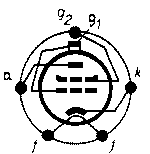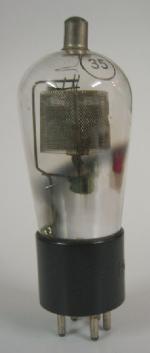
35
|
Variants
|
|||||||||||||||||||||||||||||||||||
|
Hits: 4531 Replies: 5
35 naming conventions
|
|
|
John Hupse † 28.9.20
13.Oct.05 |
1
The "35" tetrode was introduced in May 1931 by RCA as the "RCA-235". Not in 1935. It is the world's first variable-mu tetrode. A few month later Philips introduced the European version, the E455. The number "1", "2", "3" or "4" etc. before the type number (e.g. 235 instead of 35) was used to indicate the brand. In the RMorg database this additional number is used in a rather arbitrary fashion. A more concise method is to use a 2-digit model number for these tubes. So do not use "301A" or "UX201A", use "01A". Do not use "235" or "RCA235" or "435" but use "35". This will be easier for the database user (the Collector) and easier for the database administrator. |
|
Ernst Erb
13.Oct.05 |
2
Dear John Thank you very much for your thoughts. First: You are right, the data in "Radios von gestern" is 1935 for the "united" follower 35/51 and not for the separate 35 or 235. This is indead 1931 and has been corrected. Second: Please do consider that Radiomuseum.org is not showing primarily collections but wants to setup a catalogue. We have to care for each and every spelling which apears in (good) literature. If not people will repeatedly try to introduce what they have found and will not know the story behind those other namings. S we have to embrace all the alternativs (right or wrong). But to each "wrong" one we have to put a reference into the remarks. This is also true for the 01A ... |
|
John Hupse † 28.9.20
13.Oct.05 |
3
Ernest, Thank you for your kind explanation in this matter. Of course you are right in your striving towards completeness and conciseness in tube nomenclature. Perhaps an "alias" mechanism may be able to solve the current ambiguities. Like the one used for set names. E.g. 35, 135, 235, 335, 435 and RCA235 may all point to the same tube card. A practical problem in the current situation is that when data of the "35" card is updated (e.g. the introduction year is changed to 1931), the same data on the "235" card is not updated. See http://www.radiomuseum.org/tubes/tube_235.html Another problem in the current situation is that it is rather difficult to add the right pictures to all these different names. Although only a few "35" pics are present, two of these show the same tube. See attachment, at the left a "National-Union NY235" tube picture found on the "35" card, at the right another picture of the same "National-Union NY235" tube as found on the "235" card. What to do if somebody adds a NY235 card? Or even a NU35 card? Not very serious problems, I agree, but complexity will grow rapidly in a dynamic environment like RMorg... Attachments
|
|
Ernst Erb
19.Jul.07 |
4
The tubes 235 (35, 35/51) and 247 (47) are found in Rider Volume 1 in Page FADA 1-30. It is believed that Rider 1 has been made in 1930. If this is correct then we would have to date even to 1930. But this is in contrast to the first sentence in Post one - or in May 1931 it was only mentioned but not as new. Who knows more about the exact data of Riders Volume 1? Who knows more about the first anouncement about the tube 235? Please state your "proofs". Thank you. If we go to the tube page then we see that there are still silly nominations of years - for instance one is for 1928 (even without questionmark). There are only a very few compared to 1931 where it jumps to 301 models, dropping to 142 the year after. But we have also to look up the 235 - seeing that we can nearly neglect because later it is called 35 only ... |
|
John Hupse † 28.9.20
19.Jul.07 |
5
>>>Please state your "proofs". Thank you. In May 1931 initial production was commenced by Arcturus, Majestic and Raytheon under a licence of Bontoon Research Corp. Type number was 551 ("51" plus brand number). Ref: Recent Advances in Radio Tube Design, Radio Craft, May 1931, page 599. At the same time RCA brought out its own version, type number 235 ("35" plus brand number). Ref: New Types of Receiving Tubes, Radio Craft, May 1931, page 686. Due to its similarity to the 35, the 51 tetrode was discontinued in 1935. For a short time some manufacturers (e.g. Sylvania) issued tubes with a double marking (both 35 and 51). In 2005 I wrote "complexity will grow rapidly in a dynamic environment like RMorg", see above. In the current version of the RMorg catalogue already 25 tube pages are dedicated to 35 and/or 51 tubes. As it is very time-consuming to extract such a list from the RMorg tube catalogue, I can not guarantee that this overview is complete. - 35 This list will grow with time, as it seems that no tube registration guideline is available other then "We have to care for each and every spelling which appears in (good) literature". What about the C335, C-335, C351, C-351, UY-551, (American) VT35 etc. etc.? Consequence of this RMorg practice: at the moment it seems already impossible to maintain the linking between all these varants. The story after the different namings is simply not captured. The linking between radio sets and tubes is, as another consequence, "less then perfect". |
|
Roy Johnson
19.Jul.07 |
6
The most complete reference easily available is Stokes. Here it is stated that the type 551 was designed by Boonton and produced from May 1931 by various companies under licence and at the same time that RCA introduced the 235. (Stokes p 67). There is also the Cunningham C-335, "super-control grid" advertised in QST July 1931. This would indicate availability at least a few months earlier. It is clear that the -35 was available from about that time and was a relatively recent introduction as we see advertisements from Radio Surplus Corp for a new receiver in Jan 1932 using a type -35. At the same time the Auto-radio Corp has the -51 "multi-mu" in a new design. (Radio News Jan 1932). Other early receivers with the -35 include Bosch 92, GE H91, Lyric S6,7,8 Philco 70AVC and RCA R6. There may be accurate dates for these by way of corroboration. On the matter of naming that raises a far more widespread problem. It is difficult to maintain parity and equal data between "identical" tubes. It is for this reason we should restrict the entry of some "names" such as stores reference numbers and some military names for commercial tubes. However, nor easy to solve for the -nn USA series! Regards, Roy |
End of forum contributions about this tube
| Data Compliance | More Information |





